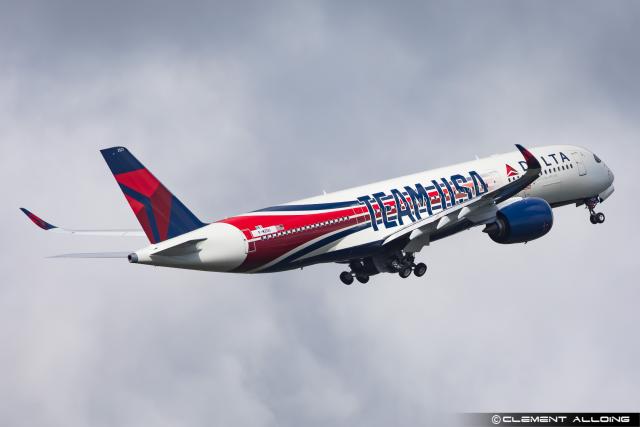- 297 commercial aircraft delivered in H1 2021
- H1 financials reflect deliveries as well as continued efforts on cost containment and competitiveness
- Revenues € 24.6 billion; EBIT Adjusted € 2.7 billion
- EBIT (reported) € 2.7 billion; EPS (reported) 2.84
- Free cash flow before M&A and customer financing € 2.1 billion
- Focus on securing A320 Family ramp-up and transforming the industrial value chain
- Board of Directors approval for A350 freighter derivative
- 2021 guidance updated
Amsterdam, 29 July 2021 – Airbus SE (stock exchange symbol: AIR) reported consolidated financial results for the Half-Year (H1) ended 30 June 2021.
“These half-year results reflect the commercial aircraft deliveries, our focus on cost containment and competitiveness, and the good performance in Helicopters and Defence and Space. Although the COVID-19 pandemic continues, the numerous actions taken by the teams have delivered a strong H1 performance. This enables us to raise our 2021 guidance although we continue to face an unpredictable environment,” said Airbus Chief Executive Officer Guillaume Faury. “We are now working to secure the A320 Family ramp up while transforming the industrial set up. Furthermore and following Board approval, we are enhancing our product line with an A350 freighter derivative, responding to customer feedback for increased competition and efficiency in this market segment.”
Gross commercial aircraft orders totalled 165 (H1 2020: 365 aircraft) with net orders of 38 aircraft after cancellations (H1 2020: 298 aircraft). The order backlog was 6,925 commercial aircraft on 30 June 2021. Airbus Helicopters booked 123 net orders (H1 2020: 75 units), including 10 helicopters of the Super Puma Family. Airbus Defence and Space’s order intake by value was € 3.5 billion (H1 2020: € 5.6 billion).
Consolidated revenues increased 30 percent year-on-year to € 24.6 billion (H1 2020: € 18.9 billion), mainly reflecting the higher number of commercial aircraft deliveries compared to H1 2020. A total of 297 commercial aircraft were delivered (H1 2020: 196 aircraft), comprising 21 A220s, 237 A320 Family, 7 A330s, 30 A350s and 2 A380s. Revenues generated by Airbus’ commercial aircraft activities increased 42 percent, largely reflecting the increased deliveries. Airbus Helicopters delivered 115 units (H1 2020: 104 units) with revenues up 11 percent reflecting growth in services and higher volume in civil helicopters. Revenues at Airbus Defence and Space were broadly stable compared to a year earlier, with two A400M military airlifters delivered in H1 2021.
Consolidated EBIT Adjusted – an alternative performance measure and key indicator capturing the underlying business margin by excluding material charges or profits caused by movements in provisions related to programmes, restructuring or foreign exchange impacts as well as capital gains/losses from the disposal and acquisition of businesses – was € 2,703 million (H1 2020: € -945 million).
The EBIT Adjusted related to Airbus’ commercial aircraft activities totalled € 2,291 million (H1 2020: € -1,307 million), mainly driven by the delivery performance and the Company’s focus on cost containment and competitiveness.
Airbus Helicopters’ EBIT Adjusted increased to € 183 million (H1 2020: € 152 million), driven by services, programme execution and lower Research & Development (R&D) spending.
EBIT Adjusted at Airbus Defence and Space increased to € 229 million (H1 2020: € 186 million), mainly reflecting the Division’s ongoing cost containment and competitiveness efforts as well as increased volume in Space Systems.
Consolidated self-financed R&D expenses totalled € 1,262 million (H1 2020: € 1,396 million).
Consolidated EBIT (reported) amounted to € 2,727 million (H1 2020: € -1,559 million), including net Adjustments of € +24 million.
These Adjustments comprised:
- € +145 million related to the A380 programme, of which € +174 million were booked in Q2;
- € -170 million related to the dollar pre-delivery payment mismatch and balance sheet revaluation, of which € +7 million were in Q2;
- € +49 million of other Adjustments, including compliance costs, of which € +75 million were in Q2.
The financial result was € -30 million (H1 2020: € -429 million). It mainly reflects the net interest result of € -172 million partly offset by the evolution of the US dollar as well as € +79 million related to the revaluation of the Dassault Aviation equity stake. Consolidated net income(1) was € 2,231 million (H1 2020 net loss: € -1,919 million) with consolidated reported earnings per share of € 2.84 (H1 2020 loss per share: € -2.45).
Consolidated free cash flow before M&A and customer financing improved to € 2,051 million (H1 2020: € -12,440 million), in line with the earnings performance. It also included a positive phasing impact from the timing of receipts and payments. Consolidated free cash flow was € 2,012 million (H1 2020: € -12,876 million).
The gross cash position stood at € 21.4 billion on 30 June 2021 (year-end 2020: € 21.4 billion) after the redemption of a € 1.1 billion exchangeable bond and prepayment of a $1 billion US bond, further improving leverage ratios in support of the Company’s robust credit ratings. The consolidated net cash position was € 6.5 billion on 30 June 2021 (year-end 2020: € 4.3 billion). The Company’s liquidity position remains strong, standing at € 33.7 billion at the end of June 2021.
Outlook
As the basis for its 2021 guidance, the Company assumes no further disruptions to the world economy, air traffic, the Company’s internal operations, and its ability to deliver products and services.
The Company’s 2021 guidance is before M&A.
On that basis, the Company has updated its 2021 guidance and now targets to achieve in 2021 around:
- 600 commercial aircraft deliveries;
- EBIT Adjusted of € 4 billion;
- Free Cash Flow before M&A and Customer Financing of € 2 billion.
***
Note to editors: Live Webcast of the Analyst Conference Call
At 08:15 CEST on 29 July 2021, you can listen to the H1 2021 Results Analyst Conference Call with Chief Executive Officer Guillaume Faury and Chief Financial Officer Dominik Asam via the Airbus website https://www.airbus.com. The analyst call presentation can also be found on the website. A recording will be made available in due course. For a reconciliation of Airbus’ KPIs to “reported IFRS” please refer to the analyst presentation.






